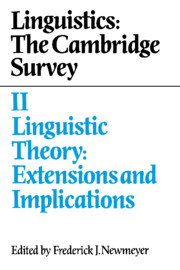Book contents
- Frontmatter
- Contents
- Contributors
- Preface
- 1 Extensions and implications of linguistic theory: an overview
- 2 Grammar and language processing
- 3 Grammatical principles of first language acquisition: theory and evidence
- 4 Second language acquisition and grammatical theory
- 5 Brain structures and linguistic capacity
- 6 Abnormal language acquisition and the modularity of language
- 7 Grammatical aspects of speech errors
- 8 Grammar and conversational principles
- 9 Discourse analysis: a part of the study of linguistic competence
- 10 Speech act distinctions in grammar
- 11 Computer applications of linguistic theory
- 12 Metrics and phonological theory
- 13 Grammatical theory and signed languages
- 14 The linguistic status of creole languages: two perspectives
- 14.I Creole languages and the bioprogram
- 14.II Are creoles a special type of language?
- 14.III A dialog concerning the linguistic status of creole languages
- Subject index
- Name index
- Contents of volumes I, III, and IV
4 - Second language acquisition and grammatical theory
Published online by Cambridge University Press: 08 February 2010
- Frontmatter
- Contents
- Contributors
- Preface
- 1 Extensions and implications of linguistic theory: an overview
- 2 Grammar and language processing
- 3 Grammatical principles of first language acquisition: theory and evidence
- 4 Second language acquisition and grammatical theory
- 5 Brain structures and linguistic capacity
- 6 Abnormal language acquisition and the modularity of language
- 7 Grammatical aspects of speech errors
- 8 Grammar and conversational principles
- 9 Discourse analysis: a part of the study of linguistic competence
- 10 Speech act distinctions in grammar
- 11 Computer applications of linguistic theory
- 12 Metrics and phonological theory
- 13 Grammatical theory and signed languages
- 14 The linguistic status of creole languages: two perspectives
- 14.I Creole languages and the bioprogram
- 14.II Are creoles a special type of language?
- 14.III A dialog concerning the linguistic status of creole languages
- Subject index
- Name index
- Contents of volumes I, III, and IV
Summary
Introduction
The goal of developing a theory of second language (L2) acquisition based on a principled theory of language is not new. Two of the most well-developed approaches to the study of L2 acquisition contrastive analysis (CA) (Fries 1945; Lado 1957) and creative construction (CC) (Dulay & Burt 1974) were each based upon a version of an available theory of language. A traditional CA model, in which L2 acquisition is thought to consist of the learning of a fixed set of linguistic habits, was based upon a structuralist approach to language. A CC model of L2 learning, in which L2 acquisition is thought to be a creative rule-governed process, was based upon a version of a generative theory of language. Though CA and CC were each able to capture the sense of one important component of the L2 acquisition process – CA the role of the first language (LI) experience, and CC the role of principles of acquisition independent of the LI experience – neither succeeded in providing a principled framework within which a full account of the L2 learning process could be developed. The reasons for this failure, in the case of CA, had to do, in large part, with the nature of the linguistic theory upon which it was developed. Structuralist theories, with their behaviorist grounding, focussed on language as behavior. Such theories are known to have problems explaining how knowledge is acquired or put to use (Chomsky 1959,1986).
Even though CC was articulated within a framework more consistent with current goals of linguistic theory, the imprecise formulation of the L2 model within this paradigm left it empirically untestable (see the review in Flynn 1985a).
- Type
- Chapter
- Information
- Linguistics: The Cambridge Survey , pp. 53 - 73Publisher: Cambridge University PressPrint publication year: 1988
- 3
- Cited by



